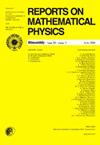ON SPACETIME ALGEBRA AND ITS RELATIONS WITH NEGATIVE MASSES
IF 1
4区 物理与天体物理
Q3 PHYSICS, MATHEMATICAL
引用次数: 0
Abstract
We consider four subsets of the complexified spacetime algebra, namely the real even part, the real odd part, the imaginary even part and the imaginary odd part. This naturally leads to the four connected components of the Lorentz group, supplemented each time by an additional symmetry. We then examine how these four parts impact the Dirac equation and show that four types of matter arise with positive and negative masses as well as positive and negative charges.
论时空代数及其与负质量的关系
考虑复变时空代数的四个子集,即实偶部、实奇部、虚偶部和虚奇部。这自然导致了洛伦兹群的四个相连的分量,每次都有一个额外的对称性补充。然后我们研究了这四个部分是如何影响狄拉克方程的,并展示了四种类型的物质,它们具有正质量和负质量,以及正负电荷。
本文章由计算机程序翻译,如有差异,请以英文原文为准。
求助全文
约1分钟内获得全文
求助全文
来源期刊

Reports on Mathematical Physics
物理-物理:数学物理
CiteScore
1.80
自引率
0.00%
发文量
40
审稿时长
6 months
期刊介绍:
Reports on Mathematical Physics publish papers in theoretical physics which present a rigorous mathematical approach to problems of quantum and classical mechanics and field theories, relativity and gravitation, statistical physics, thermodynamics, mathematical foundations of physical theories, etc. Preferred are papers using modern methods of functional analysis, probability theory, differential geometry, algebra and mathematical logic. Papers without direct connection with physics will not be accepted. Manuscripts should be concise, but possibly complete in presentation and discussion, to be comprehensible not only for mathematicians, but also for mathematically oriented theoretical physicists. All papers should describe original work and be written in English.
 求助内容:
求助内容: 应助结果提醒方式:
应助结果提醒方式:


